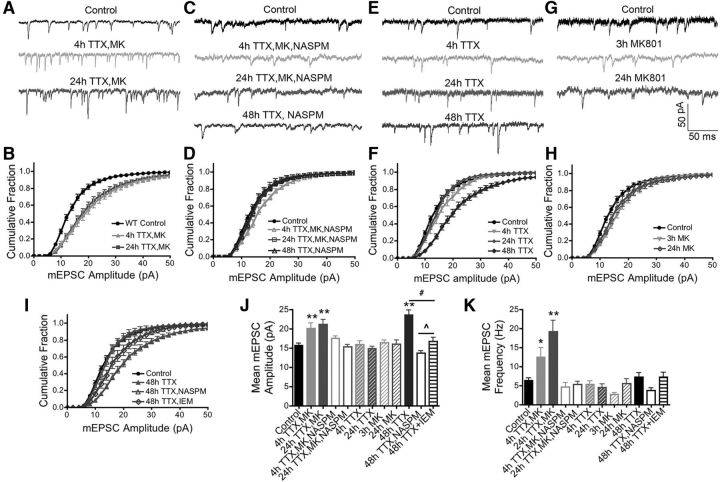Figure 1.
Homeostatic synaptic potentiation requires synaptic recruitment of CP-AMPARs in hippocampal neurons. A, Representative mEPSC recordings and (B) cumulative plots of mEPSC amplitudes showing scaling-up induced by 4 or 24 h TTX (2 μm) treatment with MK801 (10 μm) also present for the last 3 h (4 h TTX/MK or 24 h TTX/MK) in 15–16 DIV WT mouse hippocampal neurons. C, Representative mEPSC recordings and (D) cumulative plots of mEPSC amplitudes showing that inclusion of NASPM (20 μm) prevents scaling up induced by 4 or 24 h TTX/MK and 48 h TTX treatments. E, Representative mEPSC recordings and (F) cumulative plots of mEPSC amplitudes showing that 48 h TTX but not 4 or 24 h TTX alone induces robust scaling-up. G, Representative mEPSC recordings and (H) cumulative plots of mEPSC amplitudes showing that 3 or 24 h MK801 alone does not induce robust scaling up. I, Cumulative plots of mEPSC amplitudes showing that 48 h TTX induced scaling-up is prevented by NASPM cotreatment and partially reversed by acute treatment with IEM1460 (70 μm). J, Bar graph summaries of data in A–I for regulation of mean mEPSC amplitude and (K) frequency. *p < 0.05, **p < 0.01 to Control by one-way ANOVA; #p < 0.05, ∧p < 0.05 by t test. Error bars indicate SEM.

